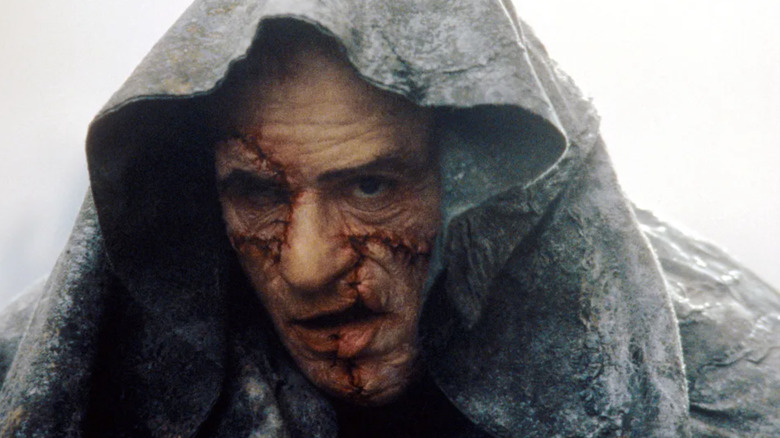Frankenstein's Most Accurate Adaptation Has A Huge Difference From The Sci-Fi Novel
We may receive a commission on purchases made from links.
"Frankenstein; or, The Modern Prometheus" turns 207 this year. Centuries after Mary Shelley's passing, many other masters of horror have retold her story. James Whale's 1930s "Frankenstein" films remain the most famous version of the story in popular culture, while artists like Bernie Wrightson and Junji Ito have brought "Frankenstein" into the medium of comics.
Director Guillermo del Toro is the next master filmmaker attempting to tame "Frankenstein," starring Oscar Isaac as the Doctor and Jacob Elordi as the Monster. The trailer for del Toro's "Frankenstein" suggests he is staying faithful to Shelley. It especially stands out how the film is using the novel's framing device, wherein Victor Frankenstein chases his Monster through the Arctic and recalls his life story to a friendly sailor.
Most "Frankenstein" movies cut out that part of the story, preferring to tell Frankenstein's story of creation and destruction chronologically. Not del Toro, it seems... nor Kenneth Branagh when directing his 1994 picture "Mary Shelley's Frankenstein." As the full title suggests, Branagh's "Frankenstein" was made and sold as being a truer adaptation of the novel. James Whale's original 1931 film was not really adapting the "Frankenstein" novel, but rather a stage play which itself was adapting the novel.
Starring Branagh as Victor Frankenstein, Helena Bonham Carter as his lover Elizabeth, and Robert De Niro as the Creature, "Mary Shelley's Frankenstein" tells the book almost beat for beat. This one doesn't streamline the narrative to get right to the mad science. It has the framing device, the early scenes of Victor's childhood and his initial fascination with creating life, his education, and how the Monster slowly kills the Frankenstein family one-by-one in revenge for his abandonment.
But even Branagh's "Frankenstein" has one big difference from the novel. Compare Francis Ford Coppola's "Bram Stoker's Dracula," which was largely faithful but turned the Count (Gary Oldman) from a pure monster into a doomed lover. (Coppola produced Branagh's "Frankenstein.")
In the novel, the Creature murders Elizabeth — but Branagh's Victor doesn't accept that death like Shelley's Victor did.
Kenneth Branagh reimagined the Bride of Frankenstein
One can feel Branagh attempting to cast off the visuals of James Whale when making "Frankenstein." The Creature is still animated by electricity, as in Whale's film, but not by a simple lightning strike. Rather, Victor constructs a metal coffin structure, fills it with water, and electricity (including from eels) flows through that pot.
The machine looks rather like a giant artificial womb (amniotic fluid included), reflecting the themes of childbirth in "Frankenstein." De Niro's Creature doesn't have Boris Karloff's green skin, square head, or neck bolts, but rather a misshapen face covered in stitches and scars.
But there's another part of the Whale-"Frankenstein" legacy that Branagh makes his own: that being the Bride of Frankenstein (first played by Elsa Lanchester). In Shelley's novel, the lonely Creature tries to blackmail Victor into making a mate for him. As his creator, Victor owes him this, and if he receives his mate he will never again seek out Frankenstein. Victor almost goes through with it, but the fear of what two Monsters could do makes him destroy the Bride he built before giving her life. That's why the enraged Monster murders Elizabeth on her and Victor's wedding night.
This subplot was left out of Whale's original "Frankenstein," but it became the backbone of his 1935 sequel "Bride of Frankenstein." Frankenstein's mentor Dr. Septimus Pretorius (Ernest Thesiger) partners with the Monster and forces the Doctor (Colin Clive) to make the Monster a Bride. But once the Bride awakens, she finds him as ugly as everyone else does and rejects him.
"Mary Shelley's Frankenstein" offers an all-new take on the Bride. After Elizabeth's murder, Victor takes her remains, assembles pieces of them into a new body, and puts it through the reanimation process, telling himself he and this reanimated Elizabeth can still be together. The Creature then tries to take Elizabeth as the Bride who his creator promised him. Elizabeth rejects them both and burns the Frankenstein family home to the ground to destroy herself (much like the ending of Whale's "Bride").
This sequence, nowhere to be found in Shelley's book, still leaves the story with the same end result. Victor's lover is dead and he pursues the Creature into the Arctic. But it makes Victor into an even more selfish character. Him destroying the Bride in the novel, though it has more terrible consequences, is about him not repeating his mistake. Branagh's Victor yet again tampers with life and doesn't consider what Elizabeth would want, only that he wants her back.
The undead Elizabeth is the most innovative part of "Mary Shelley's Frankenstein," and a pretty clever way of tying existing story threads together into something new. I'm split, though, on whether the whole story benefits from Victor learning the same lesson again — we'll see what Mr. del Toro has in store for the tragic, arrogant doctor, too.

